Arrowroot: description, care and reproduction at home
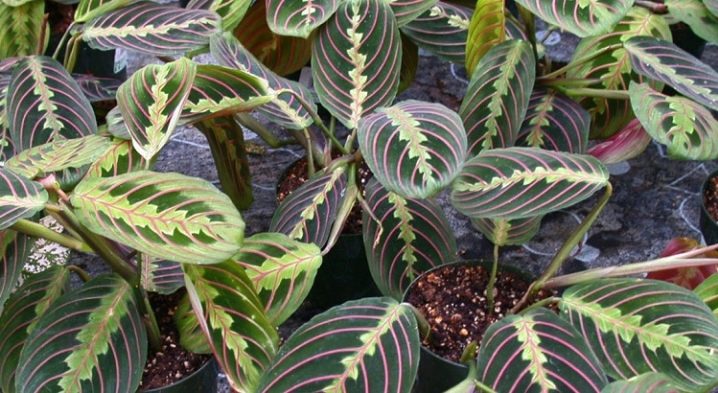
There is a popular belief that arrowroot protects the house from negative energy. She absorbs all the negative, creating only a positive aura. Some flower owners have noticed that their sleep has become much stronger. Although flower growers do not believe in popular rumor, they nevertheless notice that with the appearance of arrowroot, happiness reigns in the house, and good energy is felt around.
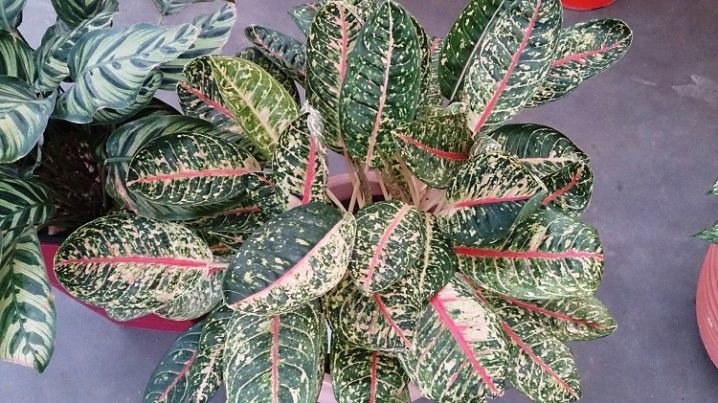
Peculiarities
Arrowroot is a perennial herb with a tuberous root system from which erect and creeping embryos grow. On young shoots, oval-shaped leaves with a thin petiole subsequently appear. The color scheme of the leaves depends on the type of plant. The most common specimens have a green leaf plate with a bright gradient. Some varieties of arrowroot are distinguished by spotty blotches on the upper side of the leaves or pronounced veins. The lower part of the leaf plate quite often has a contrasting shade.
The unusual properties of arrowroot are the curling of the leaves when unfavorable conditions arise. If the leaves are fully open, then the flower is cozy and comfortable. Folded and elongated leaf plates are a signal to the florist about a lack of moisture or sunlight. It was this feature of the plant that influenced the emergence of the second name - "praying grass". Hence the popular rumor that a prayer plant can save the house from adversity and sorrow.
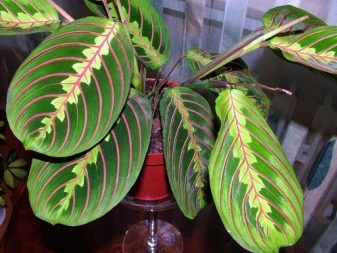
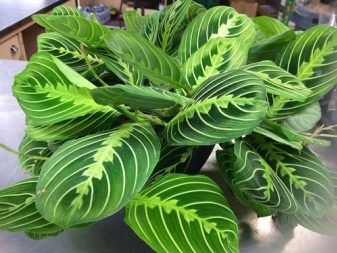
In the wild, arrowroot blooms during the warm season. The flowering of the plant occurs mainly in the summer season. The indoor flower, unfortunately, is rarely decorated with small flowers, so indoor flowering is considered a unique case.
In the agricultural sphere, the roots of arrowroot are of particular importance - the root tuber is rich in starch. In the United States, arrowroot is grown commercially because its root system is used to make starch flour. In addition, arrowroot powder has a positive effect on the human digestive system. It was also used by the Indians as a remedy for indigestion.
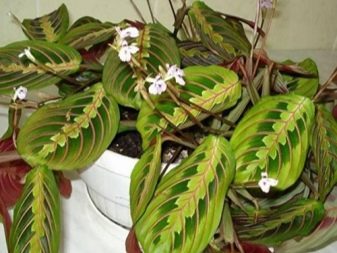
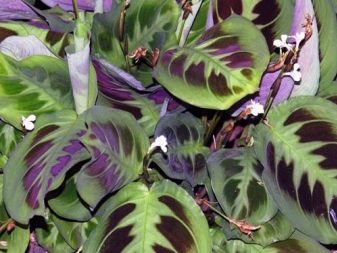
Varieties
Among modern flower growers, several varieties of arrowroot are widespread: a two-color and a three-color look. Although in nature there are many bright and spectacular specimens, for example, white-tipped arrowroot, kerhovena and black arrowroot.
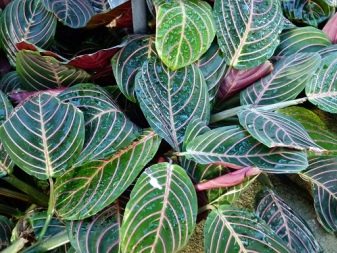
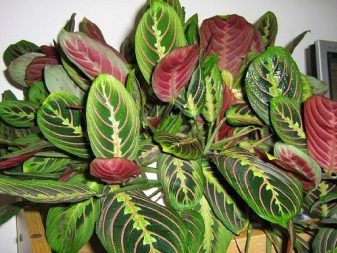
White-tailed arrowroot
The homeland of the white-necked arrowroot is Brazil, and the flower was brought to Europe in the 16th century. The ornamental plant has gained popularity due to its low height of 30 cm and painted leaves, ideally combined with any interior design. By nature, the flower is unpretentious.
The unique beauty of the plant is due to the patterned pattern of the leaf plates and the gradient color scheme. The underside of the leaves is decorated with reddish and bluish lines. The outer part is presented in a dark green shade with a silvery vein in the center, from which whitish symmetrical veins emanate. A basal rosette is formed from oval leaves.
Arrowroot arrowroot has the property of raising and lowering leaf plates, taking into account changes in the daily cycle. Thanks to this feature, the florist will be able to admire the beauty of the inside and outside of the sheets at any time of the day. The flowering of this plant occurs extremely rarely, but if the process has begun, small, white, barely distinguishable flowers bloom at the flower.
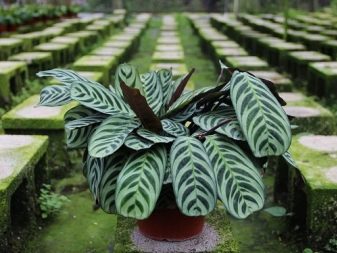
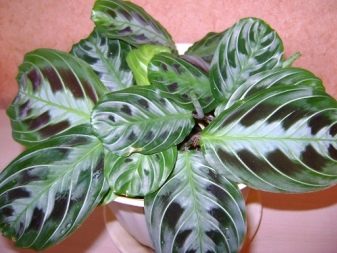
Maranta Kerhovena
Refers to a type of herbaceous plants with a small size. Its leaves grow in the form of an ellipse, with a pronounced green color. Gradient dark spots are visible on the upper side of the leaves. In the central part of the leaf plate, there is a neat white stripe with small branching veins. On the underside, the leaves have a reddish, sometimes bluish tint.
Very rarely, a plant blooms small white flowers that can form unusual inflorescences. A distinctive feature of the Kerhoven arrowroot is its endurance.
This suggests that the plant does not require special attention to itself, due to which it is quite often found in offices and various institutions.
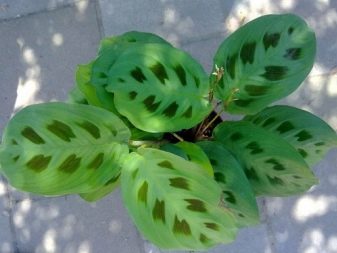

Black arrowroot
It has a very exotic look. In a botanical environment, the plant has a second name for arrowroot massage. By its nature, the flower is quite capricious, delicate and demanding. He will not tolerate negligence and inappropriate habitat.
The plant is miniature in size, rather compact. The oval leaf plate reaches 15 cm in length. The color of the leaves is dark, close to black. The leaf plate is decorated with a central vein that resembles a steel divider with silvery beams.
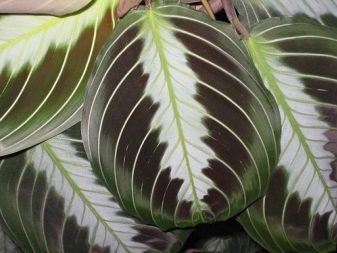

Red arrowroot
Another name for this species - tricolor, was brought to European countries from Brazil. In the wild, it grows in tropical rainforests.
The leaves have an elliptical shape with a rich dark green color, acquiring a light pink tint closer to the edges. In the center of each leaf plate there is a bright red vein, from which reddish rays emanate. On the seamy side, the vein is presented in a pink shade. The decorative appearance of the leaf plate is expressed by colorful feather-like patterns.
The maximum length of the leaf plate is 13 cm, the width reaches 6 cm. In early spring, the plant blooms barely noticeable flowers of a pale pink hue, and they bloom until the end of summer.

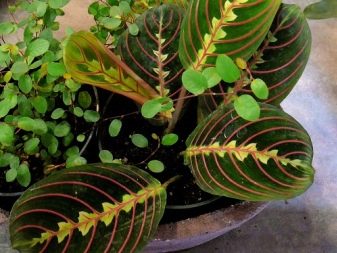
Arrowroot two-color
In appearance, the arrowroot two-colored bears a great resemblance to the arrowroot of Kerhoven. The only difference is the color of the leaf plate. The reverse side of the sheet of the two-tone specimen has a magenta tint. There is a pronounced vein in the central part of the upper side of the green leaf plate. Patterned edges of light green shades are smoothly connected to the central vein by means of light green rays.
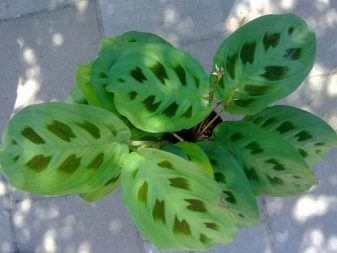

Conditions of detention
Like any other plant, arrowroot requires some care. This does not mean that it must be constantly fertilized and continuously watered. By its nature, the plant is unpretentious and everything should be in moderation.
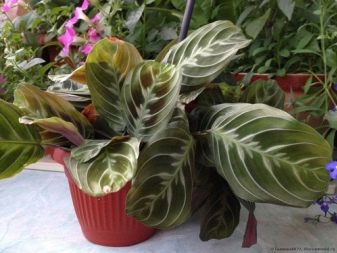
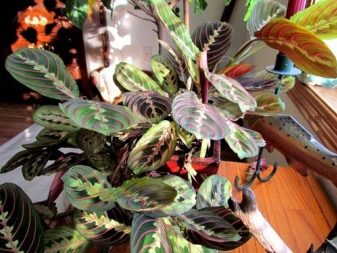
Temperature and humidity
Florists should install a room thermometer. In summer, in a room where arrowroot grows, the temperature should not exceed +25 degrees... Indoor temperature in winter should not fall below +18 degrees.
Arrowroot has a negative attitude towards low temperatures and drafts.
If the plant stands on the windowsill in winter, it must be shielded from glass with dense material or a stand that will not let the cold air flow towards the flower.
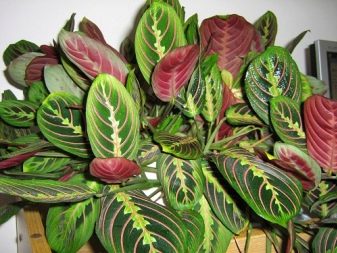
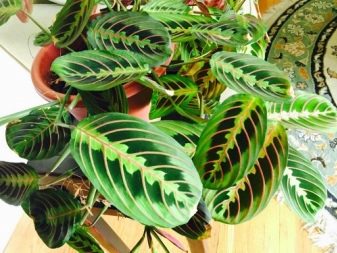
The plant needs to provide increased air humidity. The moisture mark around the flower should be at 90%. To achieve a comfortable indicator, you should regularly spray the leaves and probe the soil. If the water used for spraying is not suitable for the plant, small white spots form on the leaf blade.
During the summer period, the florist should be extremely careful and tolerant.After watering, you will have to observe for some time the excess amount of water flowing into the pan. After that, the water must be drained.
To create and maintain comfortable conditions, the distance between the pallet and the pot should be filled with expanded clay or moss so that the bottom of the pot does not come into contact with excess watering water.
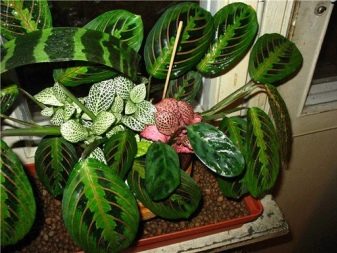
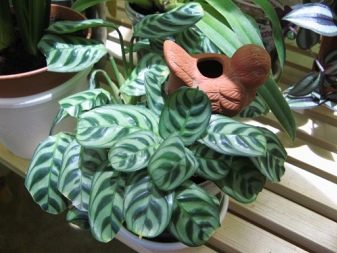
Lighting
It is quite interesting to observe the behavior of arrowroot when using different lighting. If the flower is deficient in sunlight, then its leaves will eventually stretch out and gather into one whole group. Moving the pot to the sunny side, the leaves will instantly disperse to their places and take a horizontal position.
The arrowroot plant prefers diffused light. Direct sunlight is very harmful to its leaves. Alternatively, it is suggested to use fluorescent lamps aimed exclusively at the flower.
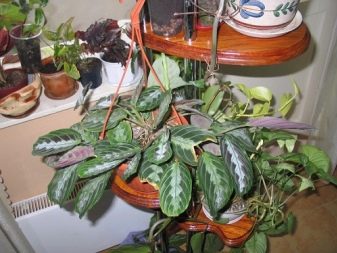
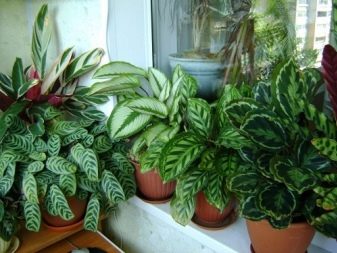
How to care?
Even an unpretentious plant that grows at home requires some care. The need for arrowroot in a humid environment makes it necessary to constantly spray the leaves and the air around it. The correct plant maintenance will lead to an extraordinary outcome. The plant will grow in size and give, with its special appearance, the majestic beauty of the room setting.
High-quality care makes the arrowroot stretch in height, which is why growers recommend pruning the plant about once or twice a year. After the pruning procedure, the plant becomes even more attractive and resembles strong young shoots.
If there is a desire to plant arrowroot, then cut off shoots should not be thrown away. They can be rooted in aquatic environments.
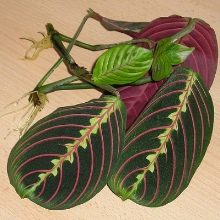
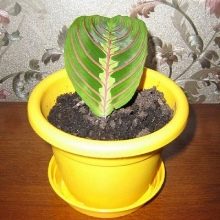
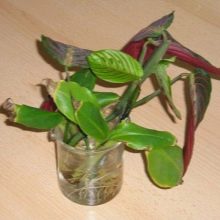
Breeders, in turn, completely cut the flower before the beginning of winter, then remove the plant in a dark room and practically do not water it. The main thing is to create a bright light, although in winter it is impossible to get sufficient natural light, so you will have to use a lamp.
Amateur flower growers, accustomed to garden plantings, seeing a significant increase in plant growth, begin to tie it to supports made of wooden sticks so that the leaves do not bend over and break. Breeders, for their part, do not advise doing this, so as not to disrupt the usefulness of the natural growth of the flower. To direct elongated shoots in height is absurd.
Growing healthy flowers requires a timely transplant of arrowroot, due to which the growing shoots will not bend under their own weight.
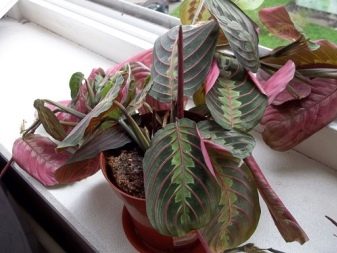
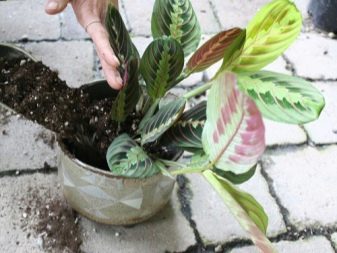
Watering
Watering the plant should not be done according to a schedule. Before filling the plant pot with liquid, you need to probe the soil. The soil should be slightly dry. In the summer, the soil dries faster, so the plant will have to be watered much more often. During the cold season, the process of watering and spraying should be alternated. Arrowroot loves these procedures for obtaining moisture, regardless of the season and temperature.
For watering the plant, use only settled water. It is strictly forbidden to take flowing liquid from the central pipeline. - it contains a large amount of chlorine. The water that has settled for several days leaves only useful substances in its composition.
An important factor is the temperature of the liquid - it should be at room temperature.


Top dressing
Arrowroot, like any other houseplant, needs timely feeding. The fertilization procedure should be carried out after planting the plant or transplanting it. In this case, the acquired concentrate of vitamins and nutrients must be diluted according to the instructions from the manufacturer.
The optimal time for the feeding procedure is from the beginning of spring to the end of autumn. As a preventive measure plants can be treated with a mineral supplement several times a week. It is versatile and suitable for all indoor flowers. Diluting the concentrate is easy: 1 gram of top dressing is diluted in 1 liter of settled water.
The flower grower must remember that arrowroot does not like abundant fertilizers. That is why it is better to have a special calendar where you can fix the dates of plant feeding.
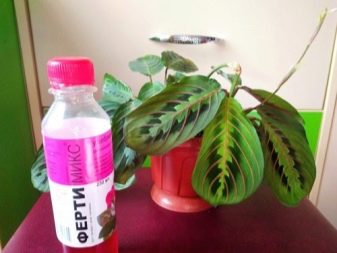

Transfer
The process of transplanting arrowroot must be carried out once every two or three years. The most suitable time for this procedure is spring. A pot should be selected before replanting a plant. A prerequisite - it must be new and slightly larger in size than the previous capacity. The increased dimensions of the new pot will allow the arrowroot root system to take a horizontal position.
Before proceeding with the procedure, the plant must be carefully examined. If curled leaves and twisted roots are found, they should be cut off. Next, a layer of drainage is laid out on the bottom of the new pot. For comfortable growth, the drainage should not be less than 3 cm in height. Broken brick or charcoal should be used as an ideal drainage system.
The transplant is carried out according to the standard scheme: the plant is placed in a pot, the root system is carefully covered with earth.
The most suitable ready-made soil in composition can be purchased at any flower shop.
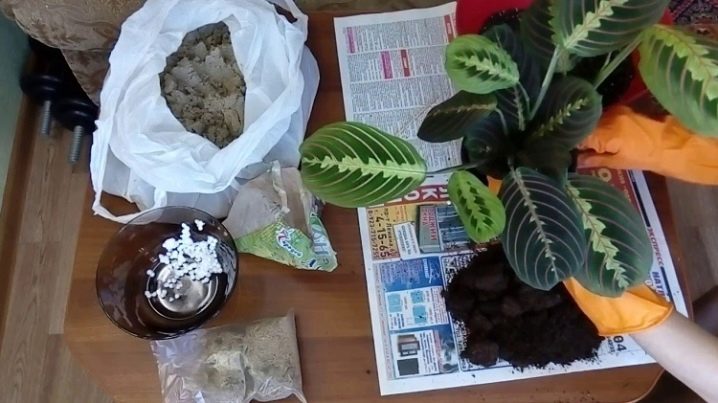
Reproduction
If the grower has a desire to breed arrowroot, he should know about two methods of reproduction. The first method allows you to propagate the plant by cuttings. Experienced breeders are advised to resort to this method in May or June. The procedure requires a step-by-step implementation of the instructions, thanks to which it will be possible to grow several healthy flowers.
- Cut off several cuttings from the main shoot, on which a pair of leaves grows. The length of the cutting should be approximately 8 cm.
- The cut part must be placed in a glass filled with warm and soft water. After a month, roots will begin to appear at the cutting.
- The embryo of an independent root system should be transplanted into a small container filled with peat.
- Cover the seedlings with a jar or plastic bag to create a greenhouse effect.
- The soil needs to be periodically ventilated and slightly moistened.
- Once the cutting has grown into a stand-alone plant, it can be transplanted into a new pot for subsequent cultivation.


The second method allows you to propagate arrowroot by dividing the roots. This procedure must be carried out at the time of transplanting the main flower. Separating arrowroot should be done with care and maximum care, since the root system of the flower is very fragile. The separated parts must be transplanted into prepared containers filled with peat. Then create a greenhouse for the transplanted shoots and wait for the appearance of new leaves.
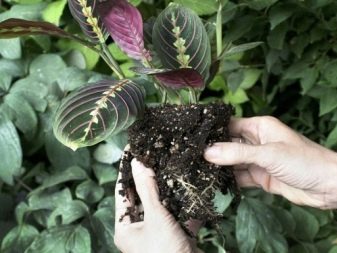

Diseases and pests
For many flower growers, houseplants are considered small children who need to be cared for, treated and monitored so that they do not get sick. Even the unpretentiousness and tolerance of arrowroot to the environment cannot guarantee the full health of the flower. With improper care, the plant can be exposed to various diseases and attacks of harmful insects. For example, spider mites, whiteflies, scale insects, thrips. To eliminate them, it is required to carry out processing with special disinfectants.
The arrowroot is not exposed to any special pests or unusual diseases. Of the above list of insects, the most harmful and dangerous are spider mites and mealybugs.
The appearance of a spider mite indicates a low humidity of the air space around the plant. The insect itself has a very small, barely noticeable body. They settle mainly on the underside of the leaf plates.
If the grower noticed that the arrowroot leaves are drying, they began to turn pale and fall off, then you should sound the alarm.

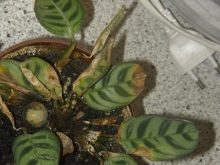
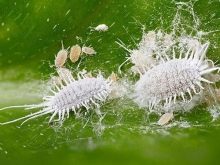
Mealybug prefers to live on leaf stalks, therefore, it is much easier to detect it than a spider mite. As a fight against these pests and any other types of diseases, you can use folk methods.
The most common treatment is in the treatment of plants with soapy water. To create it, you will need 20 grams of soap and 1 liter of settled water. Processing should be carried out at intervals of one week, not more often. As a supplement, the room in which the arrowroot grows should be moistened by any means.
If the folk method did not help, you will have to contact to industrial insecticides, among which the best are considered Aktellik and Fitoverm. The drug is diluted at the rate of 1 or 2 milligrams of a mixture of 1 liter of water. The resulting solution should be sprayed on the ground part of the plant.
If the pests did not die after the first treatment, the procedure will need to be repeated.
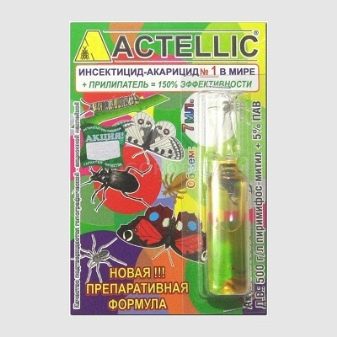
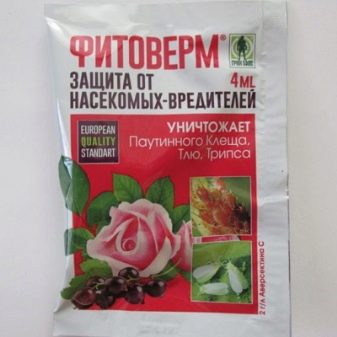
Arrowroot can be attributed to the list of unique plants. It is extremely rarely attacked by pests. And the diseases that mostly appear are easily removable.
- If the grower noticed that the stem of the plant began to rot, it should be removed from the soil, carefully examine the root, and then draw conclusions. If the stem and root rot at the same time, it is necessary to rearrange the flower in a warm room and reduce watering several times.
- Seeing that the arrowroot leaf plate turned yellow, and the tips became dry and began to curl, do not immediately panic and replant the plant, thinking that these are parasites. In fact, this is the main signal of the flower that it does not have enough air humidity. The solution to the problem will be the constant humidification of the atmosphere near the plant.
- The patterns of the leaf plates have ceased to be clear, bright, do not stand out against the background of other colors. The reason is an excess of sunlight. To change the situation, you will need to rearrange the plant in a shaded space.
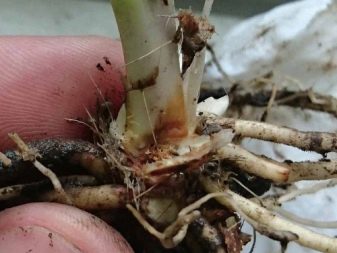
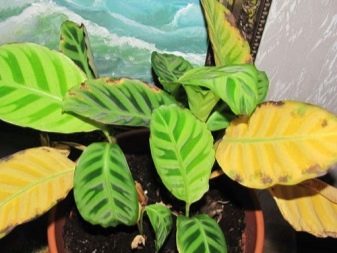
Breeders claim that if all care requirements are met, produce timely watering, do not overdo it with feeding, then in response the arrowroot will decorate the interior of the mini-garden with its unusual exotic look for more than one year.
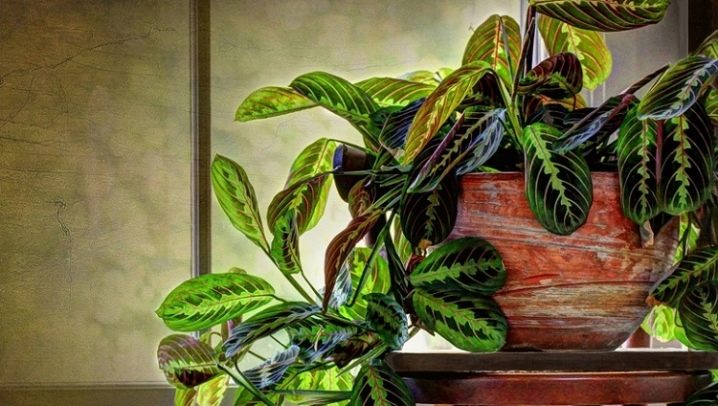
You can learn how to plant arrowroot cuttings from the following video.



























The comment was sent successfully.